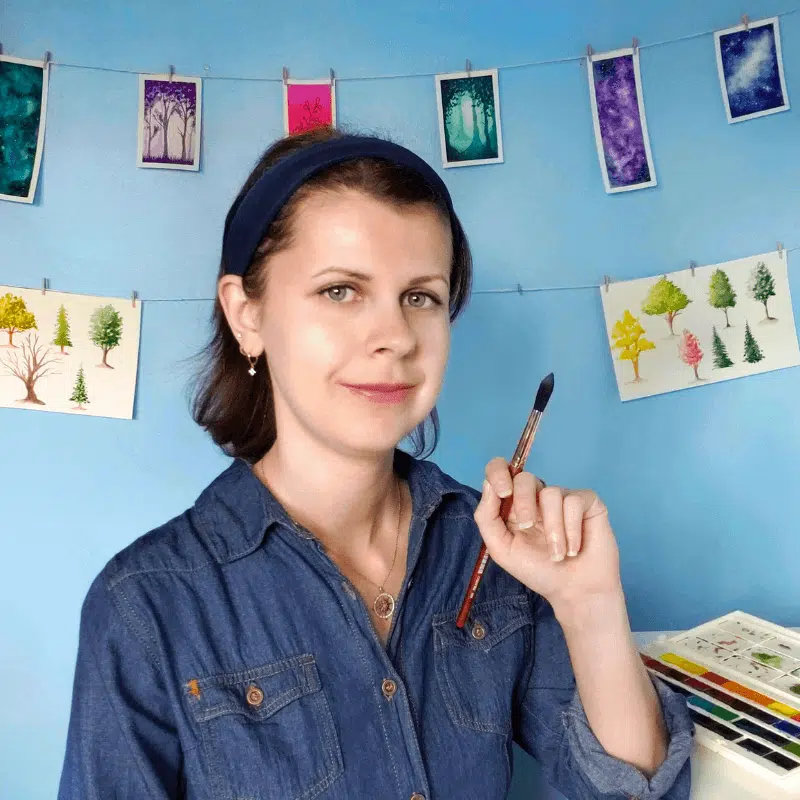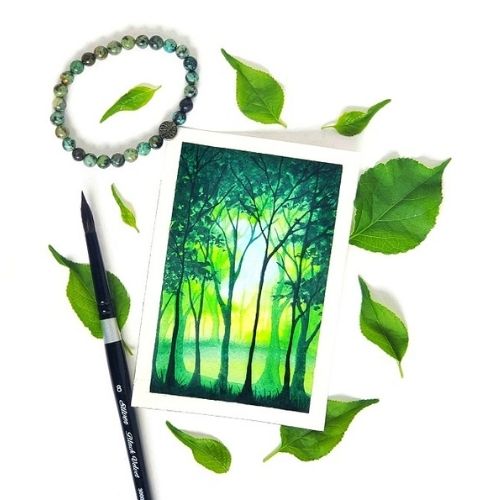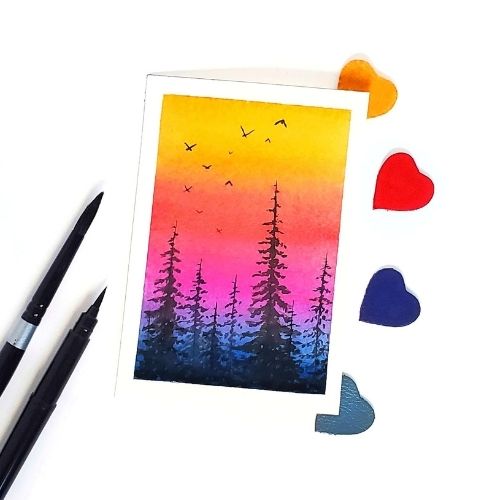As a beginner watercolourist, you often feel lost and unsure of how to practice your new hobby.
If you’re a novice, you often wonder if there are better techniques to help improve your painting process.
Thus, you sit there wondering: “What are the different watercolour techniques that I should know?”
You’re a busy person, so I’ve written this thorough article to:
- Explain 9 of the most fundamental watercolour techniques
- Show examples of what each technique looks like
- Provide instructions to help you perform each technique correctly
By the end of this article, you’ll be able to tackle your paintings with new skills and knowledge that will add dimension to your paintings.
DISCLOSURE: This post contains affiliate links. If you make a qualified purchase using any of the links, I will earn a small commission at no extra cost to you. I appreciate every sale because it supports my mission as well as the continued growth of this website.
Table of Contents
1. Paint from Light to Dark
As a watercolourist, you should know this incredibly important watercolour lesson: it’s better to paint from light to dark.
It’s not a strict rule. But it’s undeniably one of the most important lessons to learn because watercolour is a transparent medium.
This means that each underlying layer is partially visible when you paint on top of it. By layering your painting, you’re able to build up the values to create depth.
To check your paint’s transparency, conduct the following test:
- Use a marker to draw a solid black line or circle on your paper
- Swatch each of your paints by painting over the black line or circle
- Observe which paints layer over the blank ink without obstructing it. These are the transparent paints
- Observe which paints create a solid or semi-solid colour over the black line. These are the opaque paints

This colour chart was created for the White Nights Watercolour paints with 36 whole pans, which is my current favourite set of paints. The colours are pigmented and they blend smoothly.
However, if you start off too dark, it can be rather difficult to salvage your painting because it’s harder to lighten dark colours.
As a beginner, you should start with a lighter wash of paint and then slowly build up the layers. This way, you’ll be able to learn which of your paints are more transparent than the others.
Layering your paints also helps you learn about proper water control.
This knowledge will help inform your decisions about which colours you’ll use in future paintings. After all, no one wants to accidentally create muddy colours.
2. Wet on Wet Watercolour Technique
Note: In these demonstrations, I’m using the Silver Black Velvet Brushes which are my favourite brushes. I highly recommend them for their quality and affordability.
The second skill on this list in an invaluable watercolour technique for beginners. It’s called the wet on wet technique.
The wet on wet technique is applied by wetting the surface of a paper and then adding paint to flow into the wetted area. Here’s what to do:
- First, wet the paper with an even coat of water. Make sure the water glides gently across the page and that it isn’t pooling into beads of water.
- Second, load up some paint onto your brush and glide it across the wetted area. Alternatively, you can dab drops of the colour all over the wetted area.
- Third, watch as the pigment flows across the wet surface.
- Lastly, repeat step 2 by using a different colour. Watch how the colours interact as they flow into one another and blend together.
An example of the wet on wet technique can be observed in the galaxy sky shown below.
The wet on wet technique is a great skill because it teaches you how to loosen up and accept the unpredictable nature of watercolour.
If you’d like to see a watercolour tutorial with images that show you how to use the wet-on-wet technique to create a lovely variegated wash, then check out this sunset watercolour silhouette tutorial.
What’s more, the wet on wet technique is often used when creating clouds, sunsets, and landscapes.
As well, this technique is used to create watercolour galaxies and night skies because it allows the paint to flow in naturally random ways.
3. Wet on Dry
Knowing which watercolour technique to use and when is a big part of learning how to effectively paint with watercolours.
The wet on dry technique is another common method that watercolourists use to achieve greater precision in their artworks.
In this technique, don’t pre-wet the paper. It’s as simple as:
- Loading up your brush with a colour of your choice (make sure the paint is somewhat diluted with water for easy application).
- Dragging the brush across your paper to create strokes.
The wet on wet technique differs from wet on dry insofar that you have greater control over where the paint is placed.
With the wet on dry technique, you are able to control its movement in a more predictable manner because you’re applying the paints to a dry surface.
For this reason, the wet on dry technique is often recommended for more precise details such as creating branches, mountains, and blades of grass, to name a few examples.
Here, I painted a forest by using the wet on dry method.
This technique was necessary so that I could make precise tree trunks and branches.
This painting was created by following a Skillshare class by @brushpaint.n.everything
4. Dry Brush
The dry brush technique is an awesome skill that can add a lot of interesting texture to your paintings.
To achieve this result, you need to make sure you are doing a few things correctly:
- Do not dilute your paints! Add a tiny amount of water to the paint, but make sure the consistency is still mostly solid (80:20 ratio of paint to water)
- Drag the brush across your paper to create patches of unevenly distributed paint. The goal is to create many small isolated patches of dry paint.
- If your brush is too watery, dab it on a paper towel and try again. The water should not be flowing if you are using this technique correctly.

The dry brush technique can add a lot of unique texture to your paintings. For instance, applying it to mountains can give them a rocky, snow-capped, or jagged appearance.
As well, you can use this watercolour technique to create uneven bark on a tree, or it can be used to accentuate the fur of an animal.
5. Graded Wash
A graded wash is a great technique to learn because it helps you develop better control over your colour transitions.
More importantly, practicing this technique will help you better understand the range of values of any given colour.
Usually, a graded wash will be achieved by doing the following:
- Choose a colour and dilute it with water in your mixing well.
- Load up your brush (preferably a decent-sized flat or round brush if you’re covering a larger area) and paint your darkest layer at the top of the paper and then slowly move down.
- Transition from darker to lighter values as you gradually add more water to the wash, which dilutes the colour and therefore makes it lighter.
The graded wash is often used to create transitions in skies, which is what I did in the blue monochromatic painting shown below.
In this example, I used the graded wash watercolour technique to transition from a medium-dark blue to a light blue.
At first, when you’re starting to learn how to create watercolour painting, this technique may seem a bit tricky.
But fear not! With consistent practice, you’ll learn how to balance the ratio of water and paint.
6. Flat Wash
The flat wash is an incredibly useful watercolour technique! It’s also a great technique for beginners to practice during warm-up sessions because it teaches you how to steadily and evenly apply layers of paint.
But what is it?
A flat wash is when you lay down a consistent layer of paint on the surface of your paper. Flat washes are extremely useful for covering large backgrounds or when creating even layers of paint.
To achieve the perfect flat wash, you must:
- Choose your preferred paint and dilute it in your mixing well.
- Load up your brush with a moderate amount of diluted paint.
- Carefully brush the paint over your watercolour paper with a steady hand.
- Keep your strokes uniform so that the layer has a consistent look.

Keep in mind that not all watercolour brushes are suited for flat washes. For best results, opt for a big flat brush or a large rounded brush that can hold a lot of water and pigment.
By choosing the correct brush, you are much more likely to achieve the desired result: an even and consistent layer of paint.
If you’d like to see how to properly apply this watercolour technique, check out this educational flat wash technique video by The Mind of Watercolor.
7. Variegated Wash
First of all, what does variegated mean? Essentially, it means that something is multi-coloured.
So, the variegated wash is a watercolour technique that incorporates two or more colours in a wash.
Similar to a graded wash, you follow the same process, but with an additional step in which you incorporate another colour.
For example, practicing variegated washes is a wonderful way to learn how to paint colourful galaxies and sunset skies.
To achieve the best blend possible, it’s recommended that you use the wet on wet technique. Here’s how to achieve this:
- Wet the paper with an even coating of water.
- Load up your brush with the desired colour and make sure it is diluted.
- Paint an even layer across the top of the page.
- Add water to the mixture to dilute the colour and blend it with the previous mixture as you transition down the page.
- Rinse off your brush and load it up with a second diluted colour.
- Beneath the first colour, gently glide your brush across the paper and observe how the colours bleed into one another.
- For a smooth blend, rinse off your brush and glide it across the paper where the two colours meet. Doing so will encourage the pigments to mix.
Variegated washes can create some really beautiful transitions in colours.
Take this forest painting, for example. The transition from golden yellow to blue shows the viewer what time of day it is.
8. Varying Your Brush Strokes
Understanding which brushes achieve certain results is a fundamental watercolour technique that you must learn in order to use each brush to your advantage.
As a beginner, however, you don’t need a fancy selection of brushes. As you progress, you can expand your repertoire.
A great set of watercolour brushes are the highly-recommended Silver Black Velvet Brushes which are made of a blend of synthetic and squirrel hair.
They’re soft, they can create lots of brushstroke variation, and they’re high-quality brushes that can be purchased at an affordable price.
Note: For more information about watercolour brushes, check out this article regarding my most recommended watercolour supplies and products.
Often enough, good quality brushes with a fine pointed tip are much more versatile than brushes that have a rounder tip.
This is something to keep in mind when you buy your first set of brushes because opting for cheap brushes without a pointed tip will often limit your range of brushstroke techniques.

In addition to round brushes, here is a short list of brushes you may consider adding to your collection as your painting skills develop:
- Flat brush: it’s great for putting down even and consistent layers of paint over a large surface.
- Mop brush: it holds a lot of water, which makes it ideal for evenly wetting a large area at one time.
- Rigger: it’s a super fine brush with long bristles, which makes it great for detailing and precision.
Knowing how and when to use your brushes gives you the knowledge to leverage each brush’s capabilities.
9. Splattering
Last but not least is the super fun splattering technique!
This technique is great because it allows you to speckle tons of tiny dots all over your artwork to give it a more whimsical or stylized appearance.
In order to achieve this look, you need to be careful with how much water and paint you mix together. If you use too much water, you may accidentally flick drops of water all over your painting.
So, it’s best to:
- First, dilute your colour of choice but don’t make it too watery.
- Second, conduct a few splattering tests on a scrap piece of paper to make sure you have your desired consistency.
- Third, grab a second brush and repeatedly tap it against your loaded up brush. The tapping motion will encourage the watery paint to release from the brush and splatter all over your paper.
- If the splatters are too big or too watery, simply take a tissue and dab the spot. When you’re done, give it another try.
Note: You can use a toothbrush instead of a round brush if you want more splatters that are tinier in size. This is a great method for achieving tiny white stars in a galaxy or night sky painting.
Splattering is often used to create many little stars in night sky paintings.
As you can see, the stars are splattered across the sky as well as on the water’s surface to give it the appearance of reflected stars.
Conclusion
There you have it: 9 awesome watercolour techniques that will greatly improve your abilities as a beginner watercolourist.
Of course, there are many more watercolour techniques than the 9 discussed on this list. But these are the fundamental skills that you should learn before moving on to advanced watercolour techniques.
So be brave and experimental!
Try using these different techniques in your watercolour paintings to create all kinds of neat effects and textures.
Oh, and these painting techniques can also be applied to those of your who paint with gouache watercolours.
Which watercolour technique is your favourite? Share your opinion in the comments below!

Miranda Balogh
Artist & Online Educator











I’ve been practicing with watercolors all year. So these are some great ideas to try. The dry brush technique sounds the most intimidating, but that’s the one i want to try next. Thanks for the tips!
Amazing! I’ve also been practicing with watercolours all year because quarantine has given me a lot of time to focus on watercolour painting. As well, the dry brush technique is a lot of fun because it creates really nice textures, so definitely give it a try the next time you paint!
Great tips. Thank you for sharing
Thank you for taking the time to read this blog post!
I am not an artist at all and not as familiar with painting. But this really makes me want to give it a try! My hold back is I never know exactly what to do or how to do it. This post goes into a lot of different useful techniques. I think I will give it a try!
It’s really cool that you want to give watercolour painting a try. Good luck!
Thanks for the great tips! I love the way your pictures came out, and they really help to understand your steps/descriptions. Will have to try some of these techniques out. Thanks for sharing
You’re welcome! I’m happy that you found the watercolour paintings useful.
I will show this to my daughters. Nice tips and teaching. Thanks for sharing
Thank you! I hope they enjoy this article.